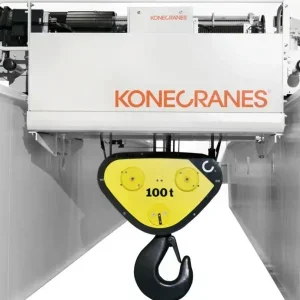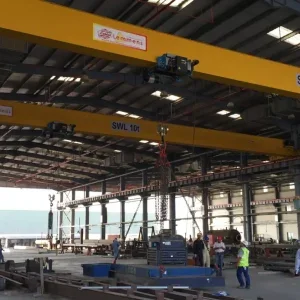Australia’s economy has continued to operate on its now familiar two-speed basis, with mining and the extractive industries pushing ahead stridently while other industries lag behind rather more hesitantly.
In New Zealand, the story is all about reconstruction after 2011’s devastating earthquake, which did its best to delete South Island’s Christchurch from the map.
Prior to the earthquake, the trend in New Zealand was a diversification of the economy to make it less dependent on agriculture. After several sluggish years, New Zealand outperformed western economies in 2010 with 2.1% growth. Then the earthquake came in February 2011.
One year on, reconstruction is beginning and the construction industry is set to be busier than ever before.
Ross Haliday, general manager of Christchurch-based McCallum Engineering, says that overhead crane building activity is now returning to the peak levels of 2008 and likely to stay that way “for some years” as the Christchurch rebuild gets under way and the mining industry expands operations.
McCallum Engineering is South Island agent for Demag Cranes and, since 2009, agent for Hydromech Cranes in New Zealand, the Australian manufacturer of JLP cranes and wire rope hoists.
Haliday says that most of the crane work directly generated by the earthquake was inspections for structural integrity, plus a little remedial work. But it seems that cranes generally withstood the shakes pretty well, moving freely along their rails.
“Generally cranes were unaffected by the quakes but a lot of buildings suffered damage which caused cranes to have down-shop rail alignment issues,” he says. “The issues were with down-shop rails, where they are attached to building portal columns. A lot of columns moved— vertically and laterally.”
Current projects for McCallum Engineering include the installation of a new 4t Demag overhead travelling crane for Dunedin City Council’s new wastewater treatment plant and a 10t free-standing Demag goliath gantry crane in a concrete pipe moulding facility for Oasis Clearwater Environmental Systems.
The economies of Australia and New Zealand have become more dependent than ever before on the health of Asia, and specifically China. While what happens to the US dollar will have a knock-on impact, as it will anywhere in the world, growth in China seems to be of at least equal importance to Australia and New Zealand.
Recent OECD forecasts suggest Australia is in reasonably robust economic shape, with a healthy mining sector leading the way. International headlines conspire to suppress confidence in other industries, according to surveys by credit agency Dun & Bradstreet, and fears remain about how overseas economic problems may affect the Australian economy. Overall, however, economists are upbeat, predicting that Australia’s GDP will grow by as much as 5% a year for the next three or four years.
The construction industry is usually a good indicator of activity in the crane business. Australia’s construction industry contracted for the 19th consecutive month in December 2011.
However, it is the house building and commercial construction sectors that are the laggards, while the more crane intensive engineering construction sector has returned to growth.
“It is well documented we have a two speed economy—both in terms of industry groups and geographically,” says Warren Ashton, sales and marketing manager at Sydney-based Konecranes Australia. “The mining sector in particular is strong, however most other industries are cautious.”
Gary Russell, business development manager of North Queensland (NQ) Cranes, agrees: “Businesses related to the mining and mining service sectors are still extremely busy and experiencing high levels of growth. The general manufacturing and commercial sectors outside of mining are steady although we are not seeing anywhere near as much enquiry activity from them.”
Russell adds: “Fortunately NQ Cranes has built its strong reputation over 25 years of operation by providing quality products and service support to the mining sector and has reaped the rewards for doing so.”
With its strong customer base in mining and mining support, NQ Cranes saw inquiries up 20% in 2011 and turnover rise 13%.
Russell says that the company is confident of maintaining this annual growth because of continuing developments in the mining industry. At the start of 2012 NQ Cranes opened a new sales and service centre in Newcastle to support the Sydney and Hunter Valley mining regions in central New South Wales.
Other developments at the company include a AUD2m expansion of its Mackay head office’s administration, production and service facilities, due for completion in March, and a relocation of the Brisbane branch to new premises in Coopers Plains, with an extensive warehouse of stock and parts.
Plans for further expansion in 2012 see the company opening up in Darwin and the Northern Territory.
NQ Cranes also began serving the mining industry in New Guinea a year ago and plans to expand this operation in 2012 too.
A further international push is on the horizon. NQ Cranes is planning to participate in a mining equipment trade mission to Chile and Brazil in April.
Recent installations for NQ Cranes include: a 10t replacement double girder overhead crane for HMAS Cairns naval base in the far north of Queensland; a pair of 50t double girder cranes for building materials producer Humes/Holcin Australia in Rockhampton, central Queensland; and three overhead cranes plus two portal cranes for QAL (Queensland Alumina Ltd) in Gladstone, for use in high temperature areas.
Russell attributes the success of NQ Cranes not just to the health of the mining industry in Australia but also to the strengthening of its partnership arrangement with Street Cranes of the UK, which supplies it with hoists and crane components. “This has, and will continue to be, a major contributor of our business success and growth in coming years,” Russell says. “The introduction of the new Street ZX10 50t capacity hoist has led to increased sales and orders for NQ Cranes within the mining and mining support sectors.”
Street Crane began its relationship with Australian and New Zealand crane manufacturers more than 15 years ago. NQ Cranes is one of four established partnerships that it has. Street Crane is expecting to double its sales into these territories in 2012.
As well as NQ Cranes in Queensland and New South Wales, Street has partnerships with Modular Cranes in Melbourne, Total Hoist & Cranes in Perth and Verissimo Engineering in New Zealand.
Modular Cranes focuses on standard cranes for industrial applications, with installations in the past year in heavy engineering, mining, glass manufacturers, reinforcement converters and water utilities.
Total Hoist & Cranes in Western Australia is a relative newcomer to the industry but can already report success with some of the largest companies in the region including Rio Tinto, MCC Sino and Australia’s largest steel producer Onesteel.
Verissimo Engineering, based in Auckland, is a diversified engineering business combining manufacture with distribution of engineering products.
Street Crane gathered the managers of the four companies for a partners’ conference in January to discuss distribution and logistics issues, cooperation between the group, and implementation of new software. They also discussed recruiting sub-dealers in more local areas to develop a joined up nationwide service.
Street Crane managing director Andrew Pimblett says: “We are pleased with the expansion in Australia and New Zealand over the last 12 months. These markets have natural momentum, but as world conditions tighten we anticipate that there may be some slowing of the pace. Nevertheless, the issue that we have faced this last year was one of supply. To address this we are planning to build up local hoist stocks so that our partners can respond more quickly to local opportunities.”
For Konecranes, in line with its global corporate strategy, growth is largely centred on developing the service business, while sales of new cranes and equipment has remained steady, Warren Ashton says.
With 27 service locations across Australia and New Zealand, Konecranes expects this trend to continue.
“Our service business has some exciting new products to roll out which should help us reach our growth targets,” Ashton says. These include the company’s new Truconnect remote monitoring technology.
One of Konecranes Australia’s biggest projects in 2011 was the installation of 17 new overhead cranes at various locations for Southern Steel, the largest privately owned steel distributor in the country.
Dr Anthony Sive, Southern Steel’s general manager for business development, says that reliability and downtime are major issues for the company. “At Southern Steel we run very high spec’d cranes, typically C6/M6, because if our cranes stop, our business stops. We use Konecranes’ CXT technology hoists and we use the highest spec those hoists can get to.
”Unlike a fabrication shop, where the crane might get used three times a day to pick up a piece of steel and roll it over and put it down again, we really use our cranes. We are typically running two shift operations across the country and the cranes run continuously for the two shifts,” he adds.
Southern Steel’s new crane installations include six units between 5t and 20t SWL at its Milperra plate processing facility in southwest Sydney and five 10t cranes at its Adelaide subsidiary, Brice Metals.
Australian crane industry veteran Greg McKay, who owns Global Track, a producer of light crane systems, is feeling optimistic about business prospects both at home and abroad. His son Bruce runs the Australian side of the business and saw good growth in 2011. More exciting, however, is the prospect of the export business taking off.
Global Track produces what Greg McKay believes is the industry’s biggest manual bridge crane, up to 15m long and 2t SWL. Manual bridge cranes normally only go up to 10m in length and 1t capacity, he says. Demag or Kito electric hoists provide lifting power, but long and cross travel are achieved by a simple push.
The characteristic of the Global Track system is a single pivotal connection via a bearing pivoted U bracket connected to the cross travel bridge. The upper pivotal bearing allows the bridge to oscillate in the direction of the load movement. The pivotal system has the load applied between the pivot points allowing a lever reaction, which reduces the operator effort. Because the system requires less effort, the size of bridge can be greatly increased. Just 20kg of effort can move a 2t load, it is claimed.
Greg McKay now spends most of his time in Ningbo, China where production of Global Track crane systems has now been set up and the company is ready to ramp up production. He is in negotiations with an international lifting company that wants to take up to 3,000 units into major overseas markets, he says. If it comes off, it is a deal that will transform Global Track.
Greg McKay also has other products in development, including a catenary cable trolley that can have flat or round cable attached. By changing adapters it can attach vacuum or air hoses. The trolley is attached to the cable by slackening a wing nut and turning a plate, he says. The electrical cable is attached by slackening a wing nut, fitting the cable and tightening the cam clamp and wing nut. “No spacers, nuts or bolts to drop while fitting the cable trolley,” he says. “I am currently getting the provisional patent lodged for this unit.”
He has also developed a hook for the wind turbine industry that fits onto the chain of a hoist above the main hook to provide a secondary load attachment point. He had noticed that hoists inside wind turbine nacelles were rarely used to capacity but it took time to lift everything up seperately. McKay’s device enables two loads to be safely attached at once, and so speed up operations.
With his new products in development and deals in the pipeline, McKay appears to represent the inventiveness, hard work and can-do attitude that have characterised Australian engineering for many years. Judging by the current state of the Australian crane industry, there is no sign of that changing.






